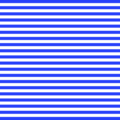Vichy pattern
Various woven textile patterns can be summarized under the term Vichy pattern . Typically these are colored strips that alternate with equally wide spaces and can also be superimposed in a crossed manner. Typical colors are red, blue and their pastel tones on a white base fabric. Different and multi-colored designs are now just as common.
The fabric is created on the loom by alternating warp and weft strips of the same width . As a simple, minimalist and high-contrast design, it was originally used for bed linen, pajamas, etc. a. at the military. It was picked up by fashion in the 1950s and is now considered a classic.
In the English language, this pattern is known as the gingham pattern .
Vichy stripes
Stripes of the same width alternate in the basic color and additional color. Vertical or horizontal arrangements are possible. Such fabrics are popular for men's shirts, for example. With its coarser stripes, this pattern of fabric also became known through the clothing used by inmates of concentration camps in the Third Reich .
Vichy check or peasant check
Here opaque strips are crossed. The result is a checkered design with white, half-colored squares that are colored through at the intersections.
Further variations are possible.


